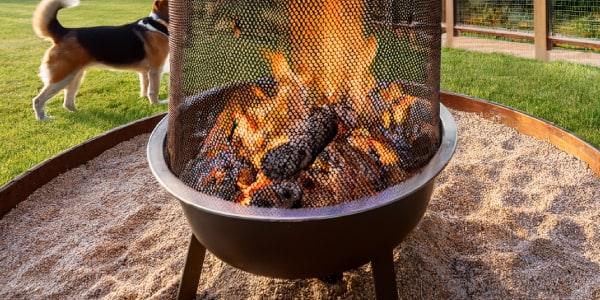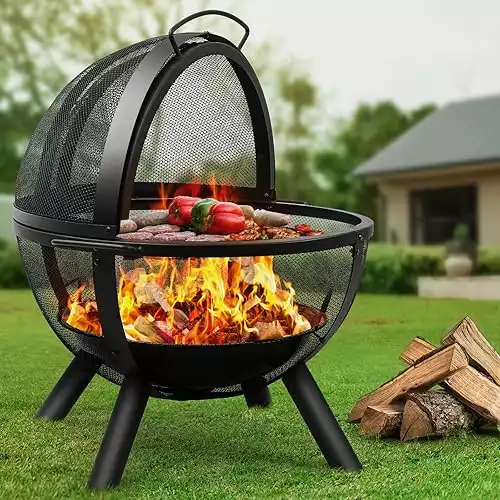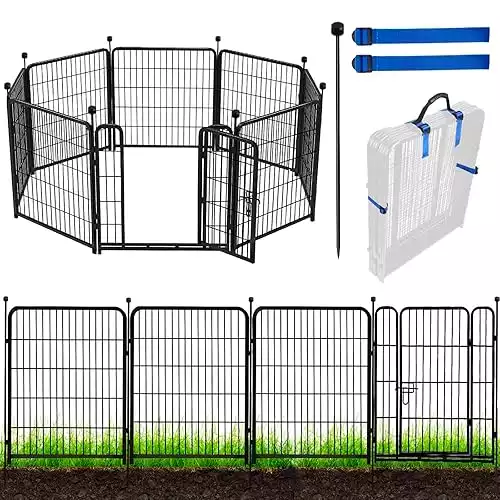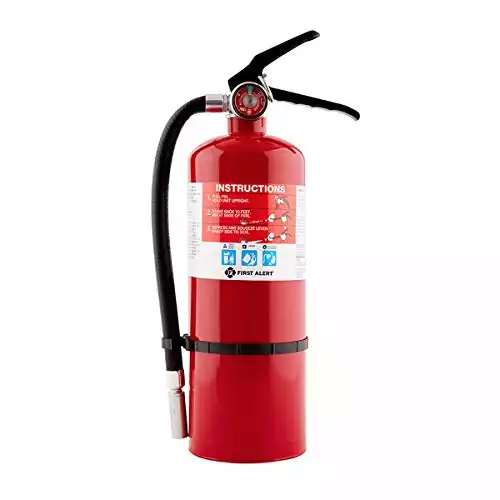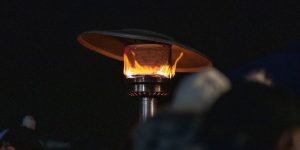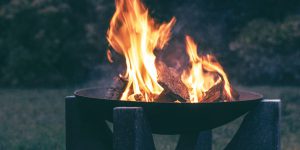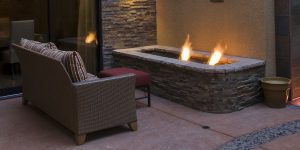
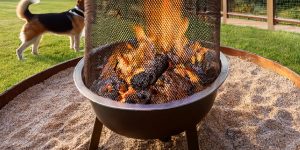
Open flames and flying embers can pose significant risks and cause injury if not tamed and correctly contained. Fortunately, with the right precautions, you can enjoy your fire pit while keeping your little ones and furry friends safe.
Read on as I’ll cover some essential safety tips and setup precautions to ensure your fire pit is both fun and secure. You’ll find a few added long-term maintenance strategies for your fire pit and a safety checklist to keep everyone safe before you light your first match.
Key Takeaways
- Choose a Safe Location for your Fire Pit: Place your fire pit on a stable, non-flammable surface which is away from any structures or trees.
- Use Protective Barriers: Install safety screens or fences and use fire pit covers to create a physical boundary between the flames and you.
- Teach Your Kids Fire Safety: Educate kids about fire dangers and establish clear rules for safe behavior.
- Supervise The Fire at All Times: Never leave children or pets unattended near an active or cooling fire pit.
- Have Safety Tools Ready: Keep a fire extinguisher, sand, or water nearby to handle emergencies.
1. Choosing the Right Fire Pit
Not all fire pits are created equal, especially when considering safety for kids and pets. The type of fire pit you choose to buy can actually help to minimize any potential safety risks. Choosing to opt for a fire pit with built-in safety features can make a big difference, whether that through how its designed or whether it has cut off switches installed.
Key Factors to Consider:
Before making a purchase or setting up a fire pit, think about the following:
- Height and Design: Raised fire pits with enclosed sides offer extra protection against accidental falls.
- Fuel Type: Propane or gas fire pits provide more control and reduce flying embers, making them safer than traditional wood-burning pits that give off sparks.
- Material: Fire pits made from durable metal or stone reduce the risk of them breaking and instability.
- Built-In Safety Features:: Fire Pits with spark screens and mesh covers add an extra layer of protection from any mischievous embers.
Safe and durable 35" fire pit with a deep fire bowl, mesh spark guard, airflow design, and heavy-duty steel construction. Features a hanging door, cooking grid, and stylish industrial design.
Best Location for a Safe Fire Pit Setup
Choosing the right location for your fire pit will ensure that you start off on a good safety footing. Poor placement can lead to unexpected accidents like your grass catching fire (been there done that), so consider the following factors before setting up your fire feature.
Ideal Fire Pit Placement:
- Keep The Fire Away from Flammable Materials: Position your fire pit at least 10-15 feet away from trees, fences, houses, or other structures that could potentially catch fire.
- Use a Fire-Resistant Base: Place the fire pit on non-flammable surfaces like stone or gravel rather than grass or wood decks. You can also buy fire-retardent matts to place your fire pit or BBQ on, which can be used to protect decks.
- Ensure It’s Stable: Choose a level surface to place your fire pit on as this prevents it from tipping over, reducing the risk of potential accidents.
- Consider Wind Direction: Position your fire pit so that smoke and sparks blow away from where your family, friends and pets might be sitting or playing.
Creating a Barrier for Extra Protection
So you’re set up with a safe location and level ground, the next step is to add protective barriers around your fire pit. This can help create a secure space that prevents kids and pets from getting too close to the hot fire pit and flames.
Effective Safety Barriers:
- Fire Pit Screens: A mesh spark screen can help contain embers that randomly fly off, especially if you’re burning wood.
- Fire Pit Fences or Gates: Set up a small, decorative fence around the pit can help keep kids and pets at a safe distance.
- Fire Pit Covers: When not in use, cover the fire pit with a sturdy, fitted lid to prevent your kid or pet from falling in and hurting themselves.
Fire Safety Rules for Kids and Pets
Fire pits can be a great feature of any outdoor space, but children and pets don’t always understand the dangers they pose. You’ll want to set clear rules and guidelines that will help them stay safe. This is easier said than done when small kids and pets are involved, but you’ve got to at least try.
Important Fire Safety Rules for Kids:
- No Running Near the Fire Pit: Tell your Kids and pets that running around the fire pit is dangerous, .
- Keep a Safe Distance: Establish a 3-5 foot safety zone where no one is allowed to cross when the fire is active unless, of course, supervised when roasting marshmallows.
- No Throwing Objects Into the Fire: Teach kids not to toss sticks, paper, or other items into the flames, no matter how fun it might be, it can cause flames to burn and embers to be given off.
- Supervision is Key: When kids and animals are present, there must always be adult supervision whenever the fire pit is in use. If you need to move away from the fire for a bit, make sure someone takes over the role of supervision or take your kids and pets with you.
Train Pets to Stay Away:
While training pets to stay away from the fire pit might take time, the following tips can help:
- Use verbal commands like “stay back.”
- Train them using treats to recognize a “fire-free zone”, or area that’s safe for them to play.
- Keep them on a leash if necessary.
For extra security, consider using pet playpens or retractable leashes when the fire pit is in use.
Supervision and Monitoring
I’ve already touched on this briefly, but even with barriers and rules in place, constant supervision is the best way to ensure safety. Kids and pets can be unpredictable, so keeping a close eye on them is essential.
Supervision Tips:
- Designate a Fire Watcher: If you’re hosting a gathering, assign someone to monitor the fire at all times; if you need a pee break, get someone else to take over for a bit.
- Use a Playpen or Leash for Pets: Keeping pets in a designated area helps prevent them from wandering too close and potentially hurting themselves.
- Sit Close but Safe: Position seating at a safe distance so children can enjoy the heat and glow of the fire without getting too close.
Fire Pit Safety Equipment You Should Have
Being prepared for emergencies can make a huge difference in keeping your family safe. Making sure you have essential fire safety tools on hand at all times will help in case of an emergency.
Must-Have Fire Safety Tools:
- Fire Extinguisher: A Class A fire extinguisher is ideal for handling wood and ember fires.
- Bucket of Sand: Sand is a great alternative to water for smothering flames; it quickly covers the flames, ensuring no oxygen can reach them. Just be careful when cleaning after, as the sand can still be hot for a while.
- Fireproof Gloves: These can help safely move logs and come in handy when stoking the fire, making sure you don’t burn your hands.
- Water Source: Even if you don’t want to douse the fire completely, having a bucket of water nearby is a smart precaution to put out the flames and cool down your fire pit quicker.
The First Alert HOME2PRO Fire Extinguisher is UL rated 2-A:10-B:C, with durable all-metal construction, a commercial-grade valve and trigger, and fights wood, paper, gas, oil, and electrical fires. Rechargeable, includes wall hook, 12-year limited warranty.
Putting Out A Wood Burning Fire Safely
Once you’re done enjoying your fire pit you’ll need to properly extinguishing the fire. This is just as important as managing it while it’s burning as leaving embers unattended can lead to unexpected flare-ups.
Safe Fire Extinguishing Methods:
- Let the Fire Die Down Naturally: Make sure to stop adding extra firewood well before you plan to put the fire out.
- Use Sand or Dirt: If you don’t want to use water, smother the embers with sand to eliminate oxygen; this can then be discarded with the rest of the ash later when cleaning.
- Stir and Check: Even after dousing the fire, use a metal poker to stir the ashes and make sure all embers are out before you leave the fire pit alone. Not doing this could harm any wildlife that enters your garden when you’re not there or spark a fire back up.
Related: How to put out a fire safely without a hose.
Additional Safety Tips for Year-Round Use
No matter the season, fire pit safety should always be a priority. Here are a few extra safety measures to keep in mind.
Seasonal Fire Pit Safety:
- Winter: Keep the fire pit clear of snow and ice buildup to prevent accidents.
- Summer: Be mindful of dry conditions and local fire bans.
- Fall / Autumn: Clear leaves and debris around the fire pit to prevent unintended fires.
- Spring: Check for damage from winter weather and perform any necessary maintenance
Related: 7 Common Fire Pit Mistakes to Avoid
Fire Pit Safety Checklist
If you’ve read this far, you’ll now know how to keep your kids and pets safe when enjoying your fire pit; however, to make it even easier for you, we’ve created a quick safety checklist you can run through before lighting and starting your fire pit:
- ✅ Is the fire pit on a non-flammable surface?
- ✅ Is there a safety barrier or screen in place?
- ✅ Are kids and pets at a safe distance?
- ✅ Do you have emergency supplies nearby?
- ✅ Are there clear fire pit rules for children?
- ✅ Are you using proper firewood or fuel?
- ✅ Is there an adult to supervise the fire at all times?
If you can check all these off, you’re pretty much good to go!
Frequently Asked Questions (FAQs)
1. What is the safest fire pit for a home with children?
Gas fire pits with enclosed flames and safety shut-offs are the safest options.
2. Can I use a fire pit on my wooden deck?
Only if you use a fire-resistant pad underneath and keep a safety barrier in place.
3. How can I teach my pet to stay away from the fire pit?
Use consistent training, keep them on a leash, and consider a physical barrier like a pet pen.
4. How far should a fire pit be from my house?
At least 10-15 feet away from any structures or flammable materials like fences and trees.
5. What’s the best way to put out a fire safely?
Take the time to let it burn down, then spread out the embers to cool it off quicker, pour sand or water on it to smother it give it a stir to ensure no heat remains.
Summing Up
A fire pit can be a fun and cozy backyard feature, but safety is key when kids and pets are around. By choosing the right fire pit, setting up safety barriers, educating your family, and following best safety practices, you can enjoy your fire pit without worry.
With these fire pit safety tips in place, you’ll create a secure outdoor space where everyone—including your little ones and furry friends—can safely relax and enjoy the warmth of a fire in a stress-free outdoor experience for the whole family!
Stay safe, and happy fireside evenings!




